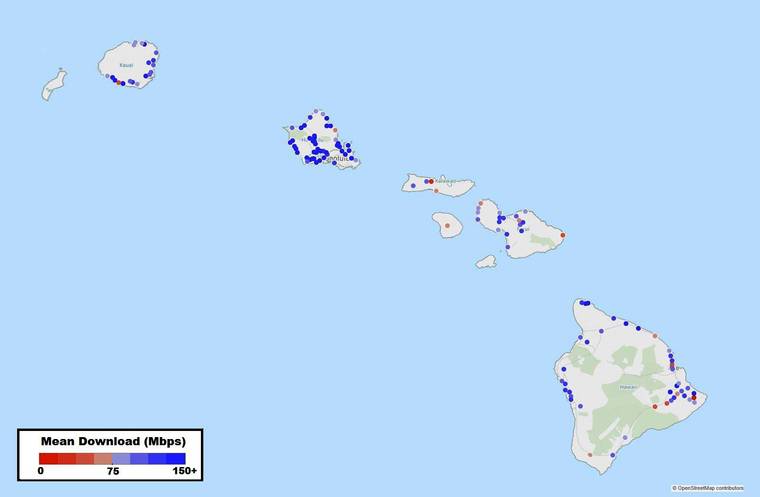Internet speeds up: Kona outpaces Hilo, but averages still lag most of the state
If your internet seems a little faster these days, you’re probably not imagining it.
The average download speed for wired broadband in Kona went up 37.8% and the upload speed went up 63.9% this year compared to last year. Hilo saw comparable increases of 16.8% and 47.6%, while the statewide average increase was 18.4% and 13.5%, according to a report from the state Department of Commerce and Consumer Affairs.
ADVERTISING
That’s no surprise to Kailua-Kona resident Aaron Stene, who closely watches telecommunications and transportation issues. He said Hawaiian Telcom Inc. is taking advantage of federal funding to replace DSL lines with fiber optics. That’s spurred competitor Charter Communications Inc. to increase the speed of its Spectrum internet service as well.
“You’re basically seeing the free market working right there. When Hawaiian Telcom increased their speeds, they basically kind of forced Spectrum to do something,” Stene said. “Compared to the past, I’ve seen a great improvement.”
The speed tests, which are self-reported by users via http://www.speedtest.net, were compiled for the month of June each year. Statewide this year, 19,802 submitted speed records were tested via the website.
The crowd-sourced data is not collected through statistical sampling techniques, so it must be used as an indication of trends, rather than statistically significant data.
“We have continued to look at ways to better provide access to unserved and underserved communities across Hawaii,” DCCA Director Catherine Awakuni Colón said in a statement. “By evaluating the speed of existing internet services offered, we hope to provide stakeholders and the public with useful insights as we work together to advance broadband access.”
But while the improvements are good news, Hawaii County still lags behind all of the other counties except Kauai. Hawaii County’s 123.70 megabits per second download speed and 22.1 Mbps upload speed pale in comparison to Oahu’s 162.99 Mbps download and 38.39 Mbps upload speeds.
The sheer size of the island and its scattered population are two factors determining speed. It’s simply not cost-effective for companies to spread so many miles of fiber optic lines to reach a smattering of homes and business.
But the island is getting a boost from $10.2 million in Connect America Fund grants over the next 10 years, most of the $18.1 million allocated to the state in May. The rather ambitious goal is to get 2,117 homes and businesses up to a 1 gigabit per second download speed and 500 Mbps upload.
“That’s a good thing considering the size of our island and the large swaths of remote areas,” Stene said. “I really think that this grant money is a real positive thing. Otherwise we’d really be lagging behind.”
One of the problems with reliability, according to a 2014 DCCA report, is that the Big Island’s fiber “ring” isn’t actually a ring. Instead, it’s more like a slightly upside-down letter “C,” with a 22-mile gap from Volcano to Pahala.
The gaps in the island’s fiber ring can lead to large regions of the island suddenly losing connectivity when a tree falls on a line, for example.
In addition, there have long been complaints on the island, especially from the Puna district, about slow internet speeds and spotty cellphone service.
“The way they have their network structured on this island, it’s very fragile,” Stene said. “It’s all great they are expanding service area but they also can’t forget the weaknesses in the underlying infrastructure.”
DCCA was awarded a $1.9 million federal grant in 2010 to develop the online database that can be used by consumers to identify the availability, speed and location of broadband services throughout Hawaii.
The grant was issued by the Department of Commerce’s National Telecommunications and Information Administration using funds from the American Recovery and Reinvestment Act.
It included approximately $1.4 million for broadband data collection and mapping activities over a two-year period and $500,000 for broadband planning activities over a five-year period.
Read the full report at http://cca.hawaii.gov/broadband/report-on-fixed-wireline-broadband-speeds-in-hawaii-july-2019.
Email Nancy Cook Lauer at ncook-lauer@westhawaiitoday.com.





